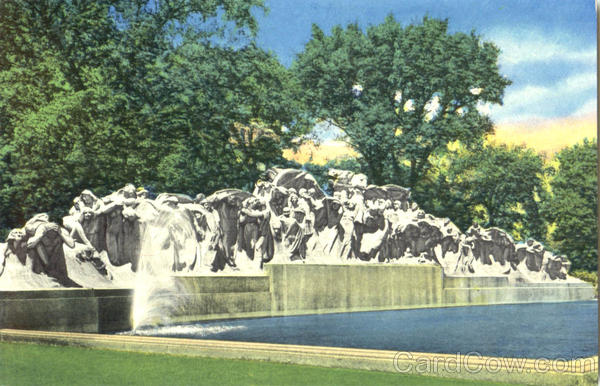This is the beautiful Fountain of Time, one of the greatest
pieces of sculpturing of modern times. It was created by
Lorado Taft, Chicago's leading sculptor — the Dean of Arts at
the University of Chicago. It was dedicated to over 100 years
of peace between the United States and Great Britain, and it
was inspired by the lines of the great British poet, Austin
Dobson.-''Time flies you say? Alas, ah no! Time stays—fur
"tis we who go." In the foreground there is a lone figure (not
shown) with his back toward our bus. This is Father Time.
He stands there motionless, with his chin in one hand, his
immortal staff in the other, looking cynically across the waters
of life at the passing of humanity. On the far right of the
work he sees man emerging from the great unknown-from
the darkness into the light. Little children being cast into the
chaos and turmoil of this life, helpless, innocent and unknow-
ing. Here, too, we find the survival of the fittest, for all those
not able to cope with realities and materialities of this life are
eliminated at an early age. The second group represents the
family group, the family being the basis of our civilization.
You can see the little ones as they play happily at the feet
of their parents, as their mother and dad go through life side
by side. Next we find the two monks, which gives us our
religious motif. The hooded monk with his eyes downcast
representing the dogmatic creed and the intolerance of religion.
The bareheaded monk with his eyes cast towards the heavens,
represents the finer, the more humane, the more charitable
phases of religion. Next we see the man on the horse the
conqueror. Having achieved the pinnacle of life he sits there
very haughtily upon that steed, followed by his camp followers
and preceded by his trumpeteers. Just below the trumpets are
the two lovers in fond embrace. Looking closely, however, you
can see the head of the third and jealous lover peering over
their shoulders, completing the eternal triangle.
Ahead of those you see an old man and old woman, bent
over with age, leaning on the shoulders of a youth. These
two old folks are no longer attracted to one another by the
physical bonds of love, but they are bound together by the
spiritual bonds which will take them, as you see them, hand
in hand, to the last mile into the great unknown. Leaning on
the shoulders of the youth reminds us that the aged must look
to youth for material support as surely as youth must look to
age for guidance and for knowledge. Then we see the three
girls, who were posed for by the daughters of Lorado Taft,
and they represent the three graces, Faith, Hope and Charity.
Following them you see what seems to be a void in the Statue.
Looking closely, however, you can make out the outline of an
arm. This void represents a derelict, a wash-out. One that
was born and went through the whole course of life without
doing himself, his fellow man, his brother any good. Without
leaving a name behind for posterity. We next see the old
man with his arms outstretched, his palms upward, supplicating
death. His life has been full, and good. He leaves his name
for posterity and is ready and willing now to step off into the
great unknown from whence he came, and claim whatever
regard he may have earned. I repeat-"Time flies, you say?
Alas, ah no! Time stays, for 'tis we who go.''
Thank You Your Gray Line Guide
2C-P2083



